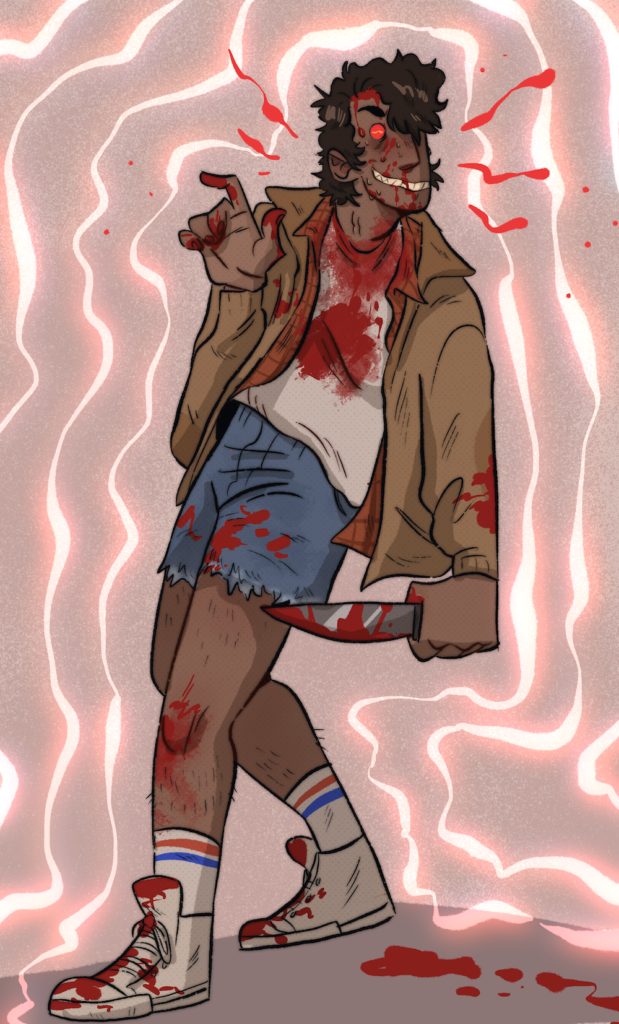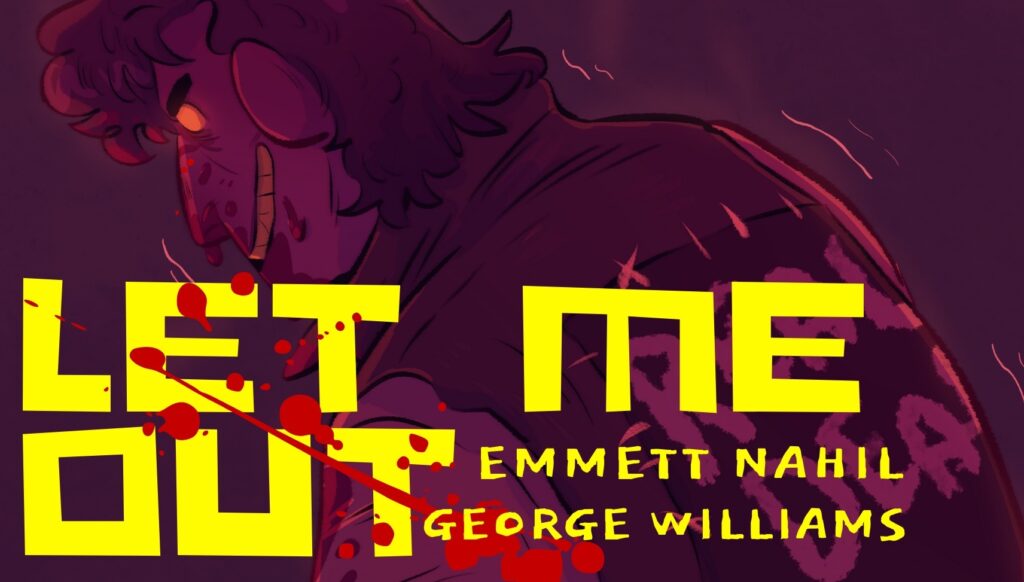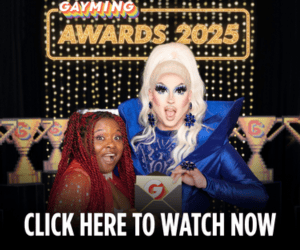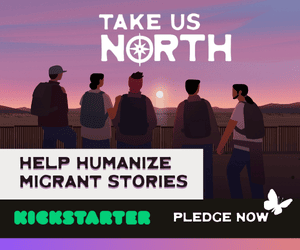Comics Corner – Let Me Out promises a HELL of a good read
Growing up queer and trying to find your place in the world can be hellish, but in Let Me Out, that becomes all too literal. When a small town is rocked by a gruesome murder, four friends – ostracised for being punk, working class, and LGBTQ+ – become the target of the town’s suspicions, convenient scapegoats for a horrifying crime. Already outsiders, and now the focus of a culture war, the friends find themselves pushed to the edge – and with a little supernatural help, are ready to push back.
Described by writer Emmett Nahil as “an unapologetically queer graphic novel that takes on classic horror tropes, and turns them on their head”, the 1970s-set Let Me Out taps into the “Satanic Panic” conspiracies that gripped America for decades, and blends in social paranoia, government conspiracy, and queer identity. With art by Croc and Roll’s George Williams, the upcoming graphic novel is running on Kickstarter now, and has already attracted enough souls to ensure its publication.
Here, we speak with Nahil on the projects influences and origins, the intersection of queer identities and the horror genre, and the politics of punk.

GM: With Let Me Out, you’re inspired by the “Satanic Panic” flare of the 1970s – what was your first exposure to that, and what made it linger as an idea for you?
Emmett Nahil: Yeah, definitely! To be honest, I first came across it as sort of a joke- “oh, did you know back in the ’70s and ’80s people thought metal and Dungeons and Dragons was devil worship?”. But then I got more into true crime and historical research as I got older, and realised it was really incredibly messed up, just as a socio-cultural incident in recent history that’s had an incredibly long tail into the present day. Right now, we are still seeing the shadows and echoes of that conservatism, homophobia/transphobia and moral panic today in so many areas (thanks Lil Nas X [whose video for Montero: Call Me By Your Name has attracted condemnation from some Christian circles for its religious imagery], I love you).
GM: So this would be stuff like Jack Chick’s infamous tract comics, notably the “real satanic power” from playing Dungeons and Dragons one, but also things like the real-life Son of Sam murders?
EN: Absolutely! In a way, Chick tracts have become a meme, and of course for some folks they were always a ridiculous joke, but for a certain slice of the Evangelical population they were always incredibly serious. And those people had influence and power in certain arenas where they did real damage and would incite actual fear. Specifically learning about the McMartin Preschool trial was huge, for me, because it has had such a bizarre afterlife outside of the damage those trials did to the people involved. ‘Michelle Remembers’, the book that came out of it, has echoes of conservative conspiracy thought that has led to stuff like Pizzagate and QAnon. It’s absolutely wild to see in the context of recent history.
GM: Onto the book itself – how did Let Me Out come about? How long had it been percolating in your head?
EN: Around early 2019 I had been working on writing a variety of short comic scripts mostly for myself, and after working on a novel I ended up trunk-ing, I really wanted to do something horror and very queer and punk! The third season of Stranger Things had come out recently, and I was annoyed with how a lot of white, straight ‘retro’ stuff set around that time seemed happy to sort of….marinate in nostalgia for a time that wasn’t super-great for a lot of marginalised folks. So I started coming up with the story of a semi-closeted trans guy who teams up with Satan. I ended up pitching the project on a Twitter literary pitch event around Halloween 2019.

GM: And how did you end up partnering with George?
EN: I’m just a humble writer, so my first thought was that if this was going to be a graphic novel I wanted to find someone whose style fit the project and who would love it as much as I did. I put out an open call on Twitter after the pitch event, and George messaged me! Which was amazing because I already was a huge fan of his work. He was super enthusiastic about doing a fun and bloody project like this, and it’s been the two of us ever since. He does all of the lines, coloring, lettering, and so forth. My agent, Tamara Kawar, has also been a huge support during the development of the comic.
GM: Let’s go into the story itself – what’s the ‘elevator pitch’ for Let Me Out?
EN: Hell yeah. After a pastor’s wife turns up dead, four queer, punk friends are caught in the menacing grip of a bigoted, increasingly dangerous town by the law enforcement who’ve picked them as convenient scapegoats. As a satanic conspiracy involving secret government bureaus and blood rituals unravels, things take a turn for the hellish… literally.
GM: Is any of that small-town bigotry drawn from personal experience?
EN: I think it’s a commentary that’s drawn more from healthy observation than any direct comparison to personal experience. I’m a young Millennial who grew up in a Northeastern suburb in the early 2000’s, which luckily is not really the same environment or era that Mitch and the gang are in. Luckily I have never had to summon the Devil, in my personal life. Yet.
GM: OK, let’s talk about Mitch and pals – who are the fantastic, or maybe fiendish, four readers are pledging their souls to?
EN: The kids!! The fearsome foursome are Mitch, Terri, Lupe, and Jackson. They’re queer, they’re working class, and they’re all punk. They have sort of found each other through necessity, and are all misfits in distinct ways. Mitch is sort of the central POV character, and he’s a trans guy who’s sort of frustrated, and stuck in Columbiania working at his family’s laundromat and trying to cope with harassment while also being semi-closeted. Terri’s a sarcastic rock star-in-waiting, Lupe is a sweet and cool type, and Jackson is a hothead with a heart of gold. They are all willing to fight for each other in a very ‘found family’ kind of way.

GM: You say they’re all queer – where do the rest of them fit in the community? Or are you dodging too many precise labels given the period setting and how identity and language has evolved since then?
EN: You’re right, queer is a good shorthand for me, because of the era! Mitch and Lupe are both trans (transmasc and transfeminine, respectively) and non-heterosexual and Terri and Jackson are both cis and generally non-heterosexual.
GM: How much do you lean into those identities, particularly for the trans characters? Did you have to do research into how trans communities lived in the 70s, for instance?
EN: I would say that their identities are as critical for them as they would be for any queer or trans person nowadays. For Mitch and Lupe, it singles them out for harassment, which is sort of still the issue with many trans folks who are perceived as such. It’s a big part of why they are scapegoated.
As to research, I’m a huge history nerd, obviously, so I couldn’t not do some research on communities in the period. But I think it’s important that these are young adults who are sort of isolated from a larger queer community. They’re not in a big city, they sort of only have each other and some of the other folks in their punk scene. That isolation and lack of support is fundamental to understanding why they’re so desperate, and why things spiral out of control so quickly. Plus, it’s a horror story. I didn’t want to delve to deep into healthcare when there’s a lot of other spooky supernatural stuff at play that’s a bit more pressing.

GM: You say Mitch and the gang are “punk” – what does that mean in the context of the story and the period setting? Purely the musical genre, or the attitude, the anti-authoritarian streak?
EN: I’d say all of the above! It’s somewhat easy nowadays to aestheticise what punk is – or was, rather – and ignore the sort of foundational political elements. I was very inspired by how people outside of big cities experience punk; that is, sort of taking over venues and generic spots and making what they could out of the space to have fun and make art. I think the ethos of punk is inherently the ethos of the marginalised and the working class, and giving the gang a way to come together over something outside of trauma was really important to me, especially since the comic is set in a time post-Stonewall, just one year after Harvey Milk’s assassination, but pre-AIDS crisis. Punk is nestled right in there too.
GM: Onto the horror side then – obviously, you’ll want to avoid too many spoilers, but what drives the group to summon the devil, and what do they get out of it? And are they all onboard with making the deal?
EN: As I mentioned before, it’s mainly desperation. A lot of the history of witchcraft and the occult is driven by people who felt disenfranchised for many reasons, and the gang is certainly that. They stumble into it through a sort of…unfortunate turn of events, but in a certain way it’s clear that Satan is also seeking them out as well as an outlet. A lot of common historical depictions of Baphomet are mistaken for images of Satan. With Baphomet as an explicitly multi-gendered entity representing balance, I felt that there’s an interesting affinity there. What exactly they get out of it and if they’re all onboard are all sort of big spoilers, so I think I’ll avoid saying any more on that for now!
GM: Does the body dysphoria some trans people may experience make for a good metaphor in horror?
EN: Yeah, I don’t want to speak for other folks when I say this, but I think that it definitely can be a fun metaphor to play with. It’s a tool in your toolkit, just like any other kind of metaphor when you’re writing horror. There’s certainly a connection to be made between body dysphoria and body horror, but I think that just comes from a sense that trans folks are usually just extremely conscious of the limits of the human body, or are just intimately aware of just how weird it is that we’re all like….brains piloting big meat sacks, y’know? The emphasis on dysphoria as a marker for transness and not gender euphoria comes from medical gatekeeping, and from us trying to get doctors to understand even a tiny percent of our experience, so in a way that in and of itself is horrifying.
GM: We’ve covered the overlap of LGBTQ+ fans and horror on Gayming Mag before, but why do you think horror is such an appealing genre for queer people?
EN: I think it’s more so that the LGBTQ+ community has always liked horror as much as everyone else! There’s just slightly different things that queer folks get out of horror. To me, there’s an appreciation for the artistry of the villain, the interest in the monstrous, and a love for the retrograde. It hits differently for us than it does for a lot of straight audiences who are used to being heroes in stories.

GM: What made Kickstarter the right route for this project?
EN: Kickstarter is a wonderful platform, and I’m familiar with it! I’ve co-run and consulted on campaigns before, and so although it was my first solo campaign I sort of knew what to expect. We ran up against some roadblocks in traditional publishing that made it clear that KS was the best route for getting the story into readers’ hands!
GM: What were those roadblocks? Publishers reluctant to handle LGBTQ+ and/or “satanic” content? And if so on the later, is that not a bit ironic, given the Satanic Panic of the 70s you’re tapping into?
EN: Not quite. I think, unfortunately, the market for big adult graphic novels is way to thin right now. It makes it incredibly difficult for new and diverse voices to break in, because there’s so much emphasis on YA and middle grade. I think there’s this perception of younger comics readers as being The Diverse Market right now which just is not true. Adult readers also want edgy, indie content that isn’t just cape comics.
GM: Just on the structure of Kickstarters for comics projects – the model seems to have largely shifted to full GNs now, rather than single issues. Is the latter unsustainable for crowdfunding now, or more a case that creators have realised “hey, might as well get the whole story out rather than risk singles”?
EN: It’s interesting, of folks I chat with about comics, there seems to be a pretty consistent 50-50 split between people who are married to the single issue model versus folks who love doing full OGNs. I’m not sure if it’s just who I’m talking to, but it seems like there’s still a lot of love for single issues out there still. I think about how successful Crowded and Croc and Roll were, and I still see folks who are super invested in working within that medium.
GM: And with Let Me Out – are there plans or possibilities for more, following the success of this, or is this that rare truly one-and-done story?
EN: I’ve had the thought, truly. But I do think it’s one-and-done!! I feel very good about how the story is wrapped up, and my biggest hope is that if people want more they will follow along with different projects coming in the future.
Let Me Out is live now on Kickstarter. Follow Emmett and George on Twitter!









